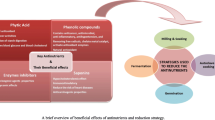Abstract
Seed of 34 cultivars of winged bean of different origin were evaluated for their nutritional composition and the antinutritional factor, the trypsin inhibitor. The values ranged from 14.1–17.6, 6.12–8.73, 21.94–34.89 and 30.86–39.05% for their fat, fibre, carbohydrate and protein contents, respectively. The protein content in defatted seed meal ranged from 33.43–47.25%, whereas the trypsin inhibitor activity (TIA) registered a wide variation from 63–123 mg g−1 with seed coat and 51–98 mg g−1 without seed coat. The strain selection-12 and NBRI selection contained the minimum TIA (63 mg g−1), while the highest value (123 mg g−1) was in variety V7, a 2-fold higher activity.
Similar content being viewed by others
References
Misra PN, Misra G (1985) Studies on the adaptability of winged bean (Psophocarpus tetragonolobus (L.) DC) to marginal soil conditions under semi-arid sub-tropics. Qual Plant Plant Food Hum Nutr 35:145–151
Gross R (1983) A composition and protein quality of winged bean (Psophocarpus tetragonolobus). Qual Plant Plant Foods Hum Nutr 32:(Special issue)117–124.
Claydon A (1983) Potential of winged bean pods and their products in Papua New Guinea. Qual Plant Plant Foods Hum Nutr 32:(Special issue) 167–177
Ham EH, Sandstedt RM (1944) A proteolytic inhibiting substance in the extract from unheated soybean meal. J Biol Chem 154:505–506
Bowman DE (1944) Factors derived from soybean and navy beans which retard tryptic digestion of casein. Proc Soc Exp Biol Med 57:139–140
Tauber H, Bernice BK, Wright RD (1949) Studies on the growth inhibitor fraction of lima beans and isolation of a crystalline heat stable trypsin inhibitor. J Biol Chem 179:1155–1161
Sohanie K, Bhandarkar AP (1954) Trypsin inhibitors in Indian food stuffs: Pt I-inhibitors in vegetables J Sci Industr Res 1313:500–503
Kantha S Sri, Hettiarachchy NS, Herath HMW (1978) Development of trypsin inhibitors on the seeds of winged bean,Psophocarpus tetragonolobus (L.) DC. Proc 34th Annual Session Sri Lanka Assoc Adv Sci 34:70
Kantha S Sri, Hettiarachchy NS, Herath HMW (1979) Development of trypsin inhibitors in the seeds of winged bean,Psophocarpus tetragonolobus (L.) DC. Proc 35th Annual Session Sri Lanka Assoc Adv Sci 35:9
de Lumen BO, Salamat, Lourdes A (1980) Trypsin inhibitor activity in winged bean (Psophocarpus tetragonolobus) and the possible role of tannin. J Agric Food Chem 28:533–536
Chan J, de Lumen BO (1982) Biological effect of isolated trypsin inhibitors from winged bean (Psophocarpus tetragonolobus) J Agr Food Chem 30:40–50
Liener IE, Nitson Z, Srisangam C, Rackis JJ, Gumbman MR (1985) The USDA-trypsin inhibitory study II. Time related biochemical changes in rats. Qual Plant Plant Foods Hum Nutr 35(3):243–258
Gumbman MR, Spangler WL, Dugan GM, Rachis JJ (1985) The USDA trypsin inhibitor III. Sequential development of pancreatic pathology in rats. Qual Plant Plant Foods Hum Nutr 35(3):259–274
AOAC (1975) Official Methods of Analysis, 12th edn. Washington DC: Association of Official Analytical Chemists
Smith C, Megen van W, Twaalhoven L, Hitchcock C (1980) The determination of trypsin inhibitor levels in foodstuffs. J Sci Food Agric 31:341–350
Garcia VV, Palmer JL (1979) Fatty acid composition of the oil of winged bean,Psophocarpus tetragonolobus (L.) DC. J Am Oil Chem Soc 56:931–932
Harding J, Martin EW, Kleiman R (1978) Seed protein and oil yields of the winged bean,Psophorcarpus tetragonolobus (L.) DC. Puerto Rico Trop Agric (Trinidad) 55:307–314
Hettiarachchy NS, Kantha S Sri, Herath HMW (1979) Further studies on the nutritive value of edible portions of 16 cultivars of winged bean (Psophocarpus tetragonolobus (L.) DC). In: Proc 35 Annual Session Sri Lanka Assoc Adv Sci 35:8–9
Rajendran R, Satyanarayana A, Biswas EE, Selvaraj Y (1978) Winged bean in India — present status and future prospects and analyis of components of yield. Presented at the XXth Int Hort Congress, Sydney 15–23 Aug
Boscan O, Dario R (1978) Feasibility of winged bean in Venezuela. Estudio sobrela posibilidad del cultivo de frijol alado (Psophocarpus tetragonolobus) en venezuela. (Es). Laguna (Philippines). In: Workshop seminar on the development of the protein of the winged bean Laguna (Philippines) 9–14 Jan
Author information
Authors and Affiliations
Rights and permissions
About this article
Cite this article
Misra, P.S., Misra, G., Prakash, D. et al. Assay of some nutritional and antinutritional factors in different cultivars of winged bean (Psophocarpus tetragonolobus (L.) DC) seeds. Plant Food Hum Nutr 36, 367–371 (1987). https://doi.org/10.1007/BF01892358
Received:
Accepted:
Issue Date:
DOI: https://doi.org/10.1007/BF01892358




